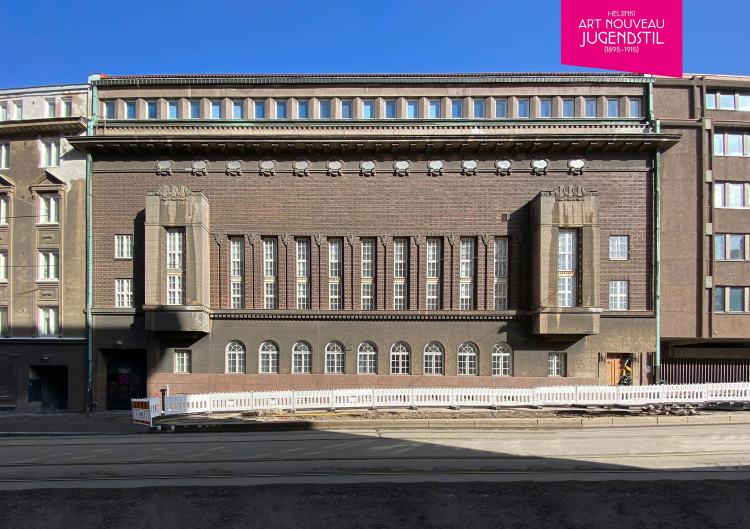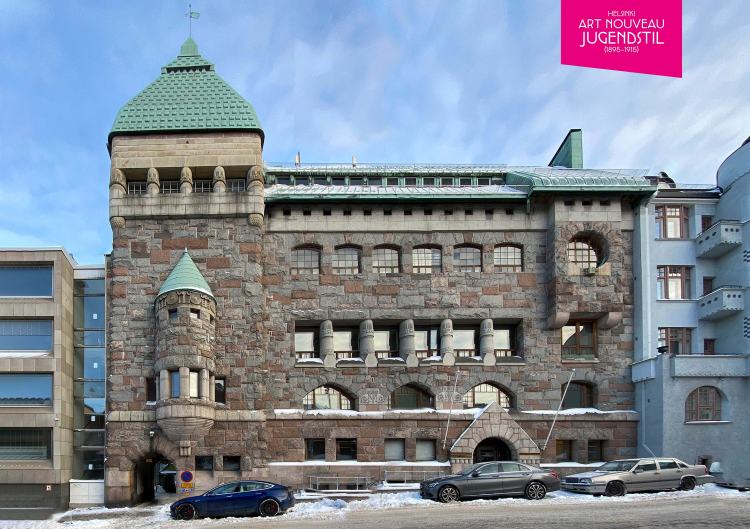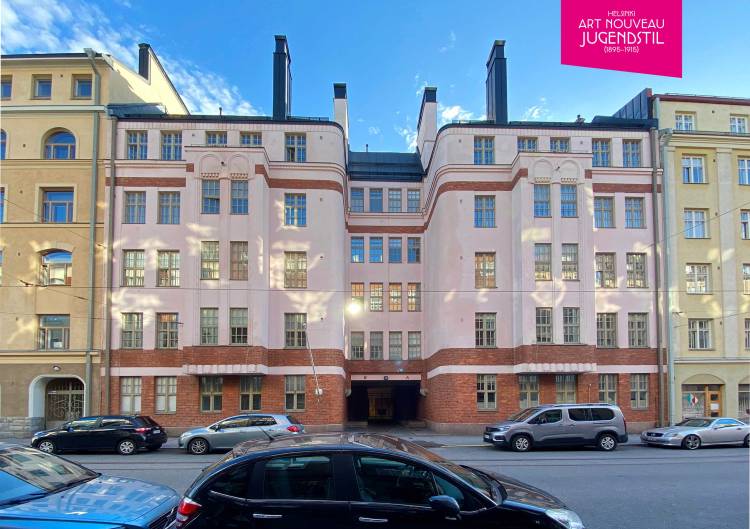
The illustrated
guide to Helsinki’s
Art Nouveau
& Jugendstil architecture
Discover the architectural secrets of one of Europe’s great Art Nouveau cities.
Helsinki is one of the important European cities for Art Nouveau architecture, alongside Brussels, Paris, Vienna, Nancy, Munich and Darmstadt. The city boasts more than 500 buildings in this remarkable style. Visitors and locals alike can still enjoy walking among the vast collection of fairy-tale streets and buildings.

1906
‘Ihantola’
VIIDES LINJA 18, KALLIO
This is the oldest of the Art Nouveau buildings in this part of the city. Ihantola means “wonderful place” in English. The street, Viides Linja, means “Fifth Line”, which comes from reference to the parallel grid lines drawn up in 1887 as “lines” for the city plan.
1906
‘Villa Johanna’
LAIVURINKATU 23—25, ULLANLINNA
Designed by Selim Lindqvist following his power station of 1909 and a world away from the National Theatre of 1902, came Villa Johanna in 1906. It was a new architectural direction — looking internationally rather than to domestic/historic models for inspiration.


1895
‘Designmuseo’
KORKEAVUORENKATU 23, KAARTINKAUPUNKI
Today this building houses Helsinki’s Design Museum, but it was originally a learning institute for boys and girls. In fact, on opening its doors in 1895 it was the very first specifically co-educational school in the country.
LATEST ADDITIONS TO THE SITE
1906-1910
‘Huvilakatu’
HUVILAKATU, ULLANLINNA
“Huvilakatu” means “Villa Street” in English. It is famous for its multicolour, three-storey houses and frequently described as Helsinki’s most beautiful street.


1898
‘Tallbergin Talo’
SATAMAKATU 7, KATAJANOKKA
This is the building that, when it opened in 1898, fired the starting gun for what became a radical change of direction for Finnish architecture. This residential building was designed by the trio of young architects Gesellius, Lindgren and Saarinen and commissioned while they were student students.


Helsinki’s Jugendstil
Districts
KALLIO
Kallio was the over-spill area for a city creaking at the seams. Many ordinary, working class people were being displaced. The area became dominated by low-rising housing up until the high-rises began appearing
… read more.
TÖÖLÖ
Töölö is home to many buildings of the late-Jugendstil era. The first “new style” building was erected here in 1910—1911. New forms and forerunners of modernity continued until around 1915
… read more.
KLUUVI
By 1900, the Kluuvi district became the new heart of Helsinki’s commercial centre. It was here the first “rugged granite” buildings appeared. Today, some 25% of buildings are in the Jugendstil style
… read more.
ULLANLINNA
The Ullanlinna district started being developed around 1904 and continued at full speed until around 1910. The Jugendstil buildings here were intended almost exclusively for Helsinki’s upper-middle classes … read more.
PUNAVUORI
Punavuori (“red granite mountain”) was originally home to the city’s workers, seamen, artists, etc. The low-rises houses were razed beginning in 1900 and today around 25% are Jugendstil buildings
… read more.
SILTASAARI
Siltasaari (“island of bridges”) is the island connecting the “old town” of Kruununhaka and the gateway to Kallio. Surrounded by water, the small district is home to interesting late-Jugendstil buildings
… read more.
KRUUNUNHAKA
Kruununhaka from the start was the original Helsinki settlement and home to the city’s wealthiest merchants, officers and elite families. Liisankatu, the major thoroughfare and gatway, first opened in 1819 … read more.
KATAJANOKKA
Katajanokka (“juniper point”) island became the up-and-coming new district of Helsinki in the mid-1890s. A distinctly upper middle-class area, its residents set themselves apart from the city’s “old money” establishment … read more.
KAARTINKAUPUNKKI
Kaartinkaupunki is the district directly south of the leafy Esplanade park. Coming after Kluuvi, this central business district is where you will find restaurants, bars and many commercial, museums and office buildings … read more.
KAMPPI
Along with Punavuori, Kamppi was originally the low-rise district of the city’s workers. It, too, was built over by large high-rise buildings at the turn of the century. Today some 25% are built in the Jugendstil style … read more.
EIRA
Among last districts to be developed, urban planners decided to pursue a new dimension in town planning. The result was a cluster of “English garden villas” and open parks and gardens
… read more.
:::: BUY THE BOOK ::::
Be among the first to get your hands on the new illustrated guide to Helsinki Art Nouveau Jugendstil. The book will soon be available for pre-order, so sign up here for email alerts and content updates
… read more.

It’s Nearly Time To Launch
Pre-order your copy of the new illustrated guide
to Helsinki’s fabulous Art Nouveau Jugendstil architecture!
FROM THE BOOK:
“The Art Nouveau influence gave Helsinki its colourful buildings, curved arches and beautifully decorated, nature-inspired walls, motifs and sculptures.
The National Romantic influence added the turrets, spires, projections and heavy-set doorways. Included in this was a splash of the national epic, The Kalevala.
The Jugendstil influence from Germany and Austria gave Helsinki its buildings with modern geometric lines, semi-circles and rectilinear shapes.”
Sign up to be the first for updates and to get your hands on the book
Get the latest news and content delivered directly to your inbox.

















